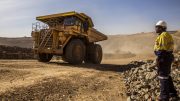We present the winner of the 2022 Northern Miner Scholarship, part of the Young Mining Professionals Scholarship Fund. Entrants were asked to write an essay outlining the mining industry’s biggest challenges over the next 10 years. For a list of all the 2022 YMP Scholarship winners, visit www.ympscholarships.com/2022-winners.
A societal shift is happening — specifically in the mindset of first-world, capitalist countries: we are beginning to recognize that unsustainable practices are coming back to haunt us. Companies and consumers alike are transitioning towards products with lifetime guarantees, and products that limit waste and eliminate inefficiency. If the Covid-19 pandemic has proven anything, it is that a stay-at-home lifestyle is not only practical, but is often preferable to much of the population.
As a university student in the first year of my PhD program in economic geology, I believe that within my lifetime, there will be a global transition towards online workplaces and recreation that is facilitated by VR technology within a metaverse. Physical products and services will be progressively replaced by virtualized NFTs (non-fungible tokens), which will be marketed as an environmentally friendly, inimitable, and unbreakable alternative to physically produced goods, and manufactured with minimal carbon emissions. I believe that the demand for physical goods will see an inverse correlation with adoption of metaverse technology, with a subsequent decline in the demand for hydrocarbons.
What does this mean for the mining industry? Mining will be increasingly focused on electronic components, and hydro, wind, solar, and battery powered machines. As evidenced by their recent price surges since 2020, metals such as lithium, cobalt, nickel, and even manganese will become incredibly valuable, as electric (and ideally self-driven) automobiles take over the trucking and delivery-based industries, whereas some more common and traditionally mined materials will likely depreciate in value. Materials such as concrete, asphalt, and iron could become much less valuable, as public buildings see less use, resulting in cities that are less motivated to engage in publicly owned projects and spaces, as people become entrenched in private spaces and opt for the increasingly convenient and comfortable lifestyle of staying at home.
The mining industry’s biggest challenge will be to adapt to these changes, and to meet the demands of a highly sophisticated, and virtualized society. I believe the mining industry will increasingly “mine” old technology and infrastructure while opening and operating fewer traditional mines. With the transition to working from home, and an adoption of virtual lifestyles, we can already see that office spaces, town halls, libraries, universities, medical facilities, places of worship, grocery stores, and restaurants have all experienced a significant decline in foot traffic, and it may not be long before some of these institutions forego in-person activities altogether. Some may transition to a strictly online/delivery-based service in order to streamline efficiency and cut unnecessary costs amidst rapid inflation. Many of these old buildings could become obsolete, and could be demolished. Many common building components such as copper and iron will be salvaged from these buildings prior to demolition, further depreciating the value of some base metal deposits. I believe the mining industry is poised to take advantage of this societal shift to a virtual takeover, but many mining companies will likely fail to make the transition. Mining companies will need to adapt to survive, as society ventures into truly unexplored territory.
Seafloor Mining
Demand for materials involved in battery power will continue to increase, which may in turn lead to seafloor expeditions, specifically in search of manganese nodules, which are also a source of cobalt and nickel — metals that are invaluable for battery-powered technology. However, extracting these materials from the seafloor comes with several different challenges, specifically the environmental impacts, permitting regimes, and its potential to inflame political disputes over territory. The world’s oceans do not belong to any one country, so who has the authority to determine who gets to mine what, and where, and define what is a reasonable degree of environmental disturbance? Unless ore deposits can be found within a country’s exclusive economic zone, mining corporations must appeal to globalized institutions such as the International Seabed Authority, which has thus far granted 19 exploration licences within the Pacific Ocean’s Clarion Clipperton Zone — an area renowned for its abundance of polymetallic manganese nodules. These discussions open the door beyond manganese nodules to the mining of other seafloor deposits such as seafloor massive sulphides, which host especially unique and fragile faunal abundances that are restricted to these hydrothermal settings.
With the rise of seafloor mining, the mining industry may be challenged by even greater political interference, as governments may choose to create public mining corporations that are perceived as acting in the public interest, rather than allowing private companies to access seafloor mining opportunities. This will present huge challenges for the mining industry, as companies may be forced to compete with government-owned mining corporations.
The ongoing virtualization of work and recreation demonstrates challenges for the mining industry. These societal shifts have repercussions for the demands of metals, specifically for those involved in battery-powered technology. These metals tend to be particularly abundant in seafloor deposits such as manganese nodules, but the logistics surrounding seafloor mining remain uncertain.
The future of the mining industry is closely intertwined with political, social, and environmental concerns, all of which are prone to unpredictable fluctuations in public sentiment. Only one thing is certain: mining is here to stay, but the concerns and demands of this sector will always be in flux, as rising sustainability expectations, environmental concerns, and social restructuring will all directly impact the demand for resources in the coming decades.
Jonathan Umbsaar is a first-year PhD student at the University of Toronto, researching the critical metal distributions of seafloor massive sulphides and how these deposits compare to the ancient analogues that we mine on land.






Be the first to comment on "Mining’s biggest future challenges will be meeting sustainability expectations – and adapting to the metaverse"